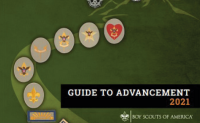![]() A rather confusing clarification came forth from the national training team recently regarding just what constitutes being “trained.” It seems there are two slightly different definitions of the term, and they apply to slightly different things.
A rather confusing clarification came forth from the national training team recently regarding just what constitutes being “trained.” It seems there are two slightly different definitions of the term, and they apply to slightly different things.
A Scouter has generally been considered Trained if he or she has completed all the courses in the basic training track for his or her position that were current at the time the courses were taken. When we were trying to update our council’s training records from user-reported input a couple years ago, Â a Scouter was considered to be trained when the required courses, or their predecessors, had been completed. For example, Scouters who took New Leader Essentials were given credit for the requirement to take This Is Scouting.
BSA now attempts to clarify this for us by defining two classes of trained Scouters. Here is their exact language, from the recent memo to council training teams:
A Scouter is considered trained for his or her position in the BSA’s ScoutNET system when they have completed a prescribed course, or sequence of courses. This could be the current course set, or even a course or courses that they took in the past. For example, Scoutmastership Fundamentals if they took it back when it was the current “basic†training.
But to be able to wear the trained patch, and for the unit to qualify under the unit Journey to Excellence (JTE) standards, trained means that they have taken the current training set for their position.Â
The national training team goes on to explain that it’s generally been presumed that an active adult leader who has completed the initial formal training sessions continues to build on his or her skills and knowledge through resources such as Roundtable, supplemental events such as University of Scouting or Pow-Wow, articles in Scouting and Boys’ Life magazines, and teaching the material to others through formal courses or informal sessions. However, they recognize that this is not always the case; thus the requirement that to be Trained (the shoulder-strip version), one must stay current on everything, including taking replacement courses when they are revised – and taking position-specific courses when changing positions (such as from Den Leader to Webelos Den Leader). Experienced leaders can volunteer to help teach the new courses and receive credit for taking them.
Further steps are being taken by the committee to make the three training criteria match more closely, and they expect to outline these steps in the coming months.
Our council’s training committee gives us a little leeway in determining whether a leader is Trained:
With the approval of the district training committee, Scouters who were fully trained under a previous “basic†training for their current role (and of course have completed Youth Protection Training within the past two years) may be given credit as “trained†if, in the opinion of the training committee, the Scouter has continued to stay up to date with the current methods and practices of the program.
As the national training team suggests (and I agree), we can never be “fully trained.” Even those with years of experience find there is always something new to be learned
Resources
The following are links to PDFs at scouting.org and may be of help in figuring out what Trained means:
- What makes a Trained Unit Leader?
- Basic Training Requirements
- Training Course Codes (so you can decipher the Basic Training Requirements)
- Top Leader Trained Date and Course Criteria (so you can see if the training you took qualifies based on when you took it)





